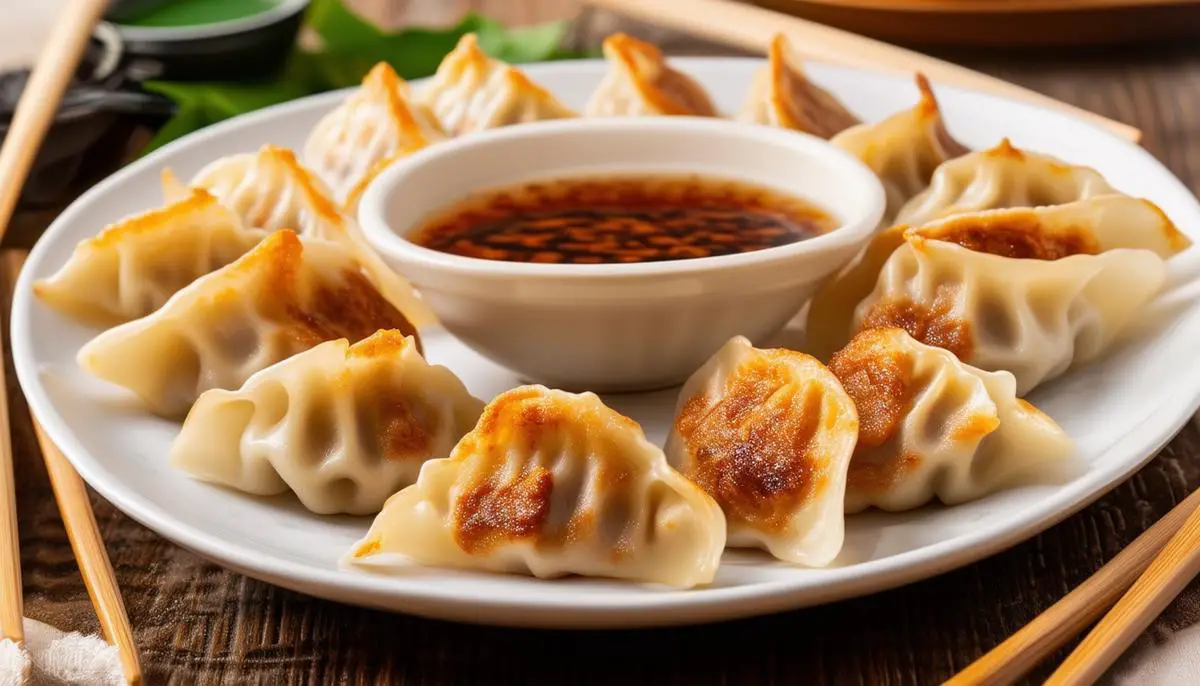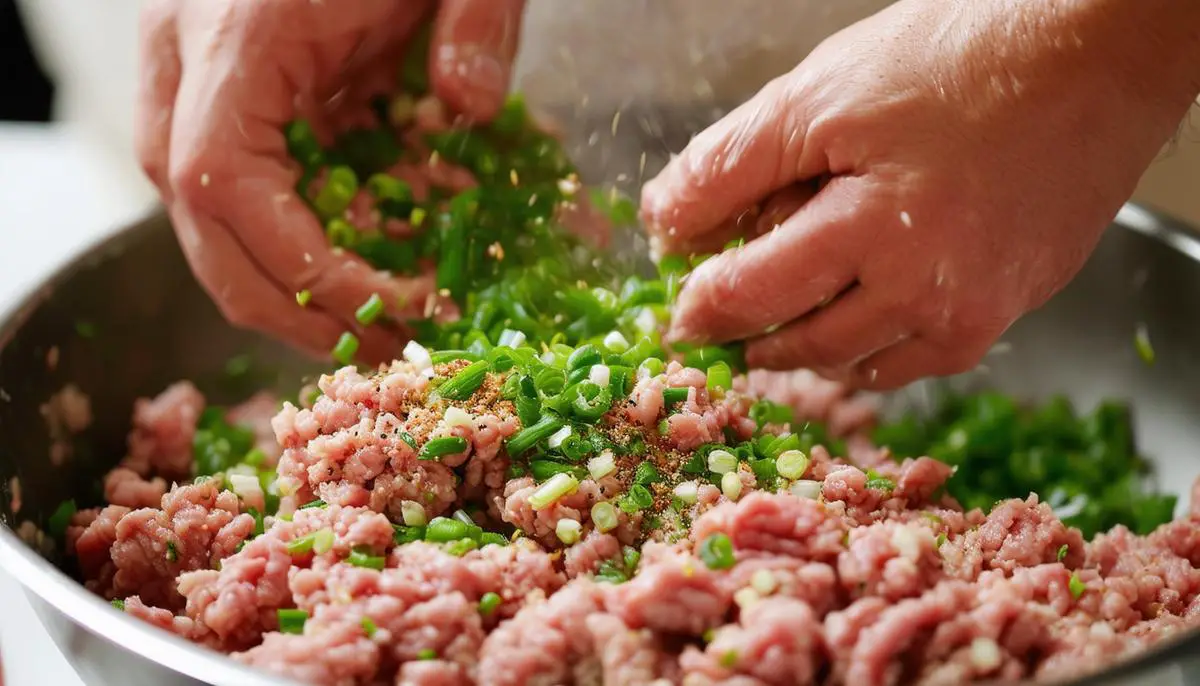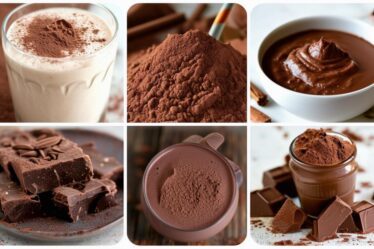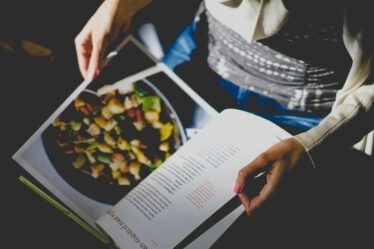
Background and Significance of Pork Dumplings
Pork dumplings have long held a special place in culinary tradition and cultural celebrations, particularly during the Lunar New Year. There's something incredibly symbolic about these little parcels of flavor—they represent wealth, good fortune, and unity.
The act of making dumplings is an art that demands attention to detail and finesse. The filling, aromatic and tantalizing, is the heart of the dumpling. Ground pork entwined with lush Chinese chives, a hint of ginger adding zest, soy sauce weaving through it all with its umami depth. Getting it just right brings families closer together.
Dumplings are more than just food; they're a tactile connection to cultural heritage. Their shape resembles ancient Chinese money pouches, signifying wealth, and the gathering to make them symbolizes unity. The repetitive, almost meditative process of making dumplings becomes a space for storytelling, laughter, passing down traditions, and creating new memories.
The rich, savory juices of the pork meld with the slight bite of ginger and garlic, the thin, tender wrapper yielding just enough to reveal its steaming, fragrant contents. The crispy bottom provides a textural contrast that brings it all to life. It's an amalgamation of flavors and textures that transcends years, geographic boundaries, and generations—an homage to heritage and identity.
Making dumplings can be precise and ritualistic, perfect for a quiet weekend afternoon. But it can also be a bustling family affair—an interactive activity that bridges gaps of age and experience. It's about the accomplishment and connectivity, not just the food on the plates but the love and care that goes into filling them.
These little pockets are symbols of tradition, conduits of culture, and expressions of love. Every bite, with the crispy exterior giving way to the rich, savory filling, is a reminder of home, no matter the location.
Ingredients Essential for Pork Dumplings
When crafting truly exquisite pork dumplings, the selection and quality of ingredients are paramount. Each component plays a crucial role in achieving the perfect balance of flavors and textures.
Ground Pork: Opt for a 90/10 lean ground pork blend, which provides moisture and flavor without being overly fatty. The richness of the pork creates a succulent and juicy filling that retains its integrity during cooking.
Chinese Chives: Unlike regular chives, Chinese chives are longer and more aromatic, offering a strong, garlicky flavor that complements the pork beautifully. Finely chopping them ensures an even distribution throughout the filling.
Ginger and Garlic: Fresh ginger and garlic add a zesty and pungent depth. Grate the ginger and mince the garlic to ensure they blend seamlessly into the pork mixture.
Soy Sauce and Sesame Oil: These two ingredients form the backbone of the seasoning. Soy sauce imparts a rich umami profile, while sesame oil offers a nutty, fragrant note. Together, they create a harmonious blend.
Green Onions: Adding a fresh, slightly sweet bite, green onions enhance both the flavor and texture. Very finely chop them to ensure they integrate well into the filling.
Egg: Using an egg helps to bind the filling together, ensuring it doesn't fall apart during wrapping and cooking.
Cabbage: Whether using Napa cabbage or a coleslaw mix, cabbage adds bulk and a slight crunch. Toss it with salt, let it sit to draw out excess water, then squeeze it dry and chop finely to prevent the filling from becoming soggy.
Dumpling Wrappers: The choice of wrapper can significantly affect the final texture. Dumpling wrappers, thicker and round, are ideal for frying and pan-searing. Wonton wrappers, thinner and typically square, can be used but lack the same structural integrity.
Variations include substituting ground pork with ground chicken, turkey, or finely chopped shrimp. Vegetarians might prefer a mix of diced mushrooms, shredded cabbage, and tofu.
Fresh ingredients are crucial. Fresh green onions, ginger, and Chinese chives bring bright, intense flavors that dried or older ingredients cannot match. Special considerations, like ensuring the cabbage is thoroughly drained and the garlic finely minced, will improve the overall texture and flavor balance.
By focusing on these essential ingredients and their proper preparation, you'll create pork dumplings that are delicious and a nod to traditional craftsmanship, filled with love and care in every bite.

Mixing and Prepping the Dumpling Filling
To achieve the perfect pork dumpling filling:
- Place one pound of ground pork into a large mixing bowl.
- Add three heaped cups of finely chopped Chinese chives.
- Integrate two tablespoons of light soy sauce, a couple of dashes of white pepper, one teaspoon of sugar, and kosher salt to taste (around one teaspoon if using Diamond Crystal kosher salt; for other brands, half a teaspoon should suffice).
- Add freshly grated ginger and minced garlic.
- Drizzle in one and a half tablespoons of sesame oil.
Using your hands, blend these ingredients thoroughly to ensure even distribution. Wear disposable gloves for hygiene and comfort.
After roughly combining the ingredients, switch to using two pairs of thick wooden chopsticks held together in one hand. Stir the mixture with vigorous circular motions. This crucial step tenderizes the meat and melds all components into a compact, cohesive mixture. The filling should transition from loose to pasty, offering a bouncier mouthfeel once cooked.
If time allows, chill the filling in the refrigerator for at least 30 minutes before wrapping. Chilling firms up the mixture, making it easier to handle and preventing potential mess.
By diligently preparing your filling in this manner, you're setting the stage for dumplings that are flavorful, tender, and expertly crafted.
Techniques for Wrapping Dumplings
The Classic Pleating Technique
- Prepare the Work Area: Ensure you have a clean, dry work surface. Set out your dumpling wrappers, a bowl of the prepared filling, a small dish of cold tap water, and a lightly floured baking sheet for the finished dumplings.
- Place the Filling: Hold a wrapper flat on your palm. Place about a heaping teaspoon of filling in the center. The amount should be enough to create a plump dumpling but not so much that it becomes difficult to seal.
- Moisten the Edges: Using one finger, lightly dab water around the entire outer edge of the wrapper. This helps to seal the dumpling. Avoid overmoistening, as it may cause the wrapper to soften too much and break.
- Fold and Pinch: Fold the wrapper in half over the filling to form a half-moon shape. Pinch the center of the half-moon to create a starting point. The edges should remain open at this stage.
- Create Pleats: Starting from the center, form 3 to 5 pleats on one side of the wrapper, moving to one end. Pinch each pleat lightly to secure it. Repeat on the other side, also pleating to the end. The folds should face the center.
- Seal: Ensure all edges are well-sealed by pressing gently but firmly along the pleats. This step ensures the filling is contained during cooking.
- Place on Baking Sheet: Lay each finished dumpling on the floured baking sheet, ensuring they don't touch to prevent sticking.
For Beginners
For those new to dumpling making, here's a simpler method:
- Place the filling in the center of the wrapper.
- Moisten the edges.
- Fold the wrapper in half to create a half-moon shape.
- Press the edges firmly to seal, skipping the pleats.
Additional Resources
For visual learners, watching video tutorials can be immensely helpful. These resources provide demonstrations of the pleating technique, making it easier to understand and replicate. Websites like YouTube often have step-by-step videos by seasoned chefs.
Common Mistakes to Avoid
- Overmoistening the Wrappers: Adding too much water can make the wrapper soggy and prone to tearing.
- Overfilling: Overstuffed dumplings are difficult to seal and may burst during cooking.
- Inconsistent Filling Distribution: Ensure the filling is evenly combined to avoid flavor imbalances.
- Improper Sealing: Make sure each dumpling is properly sealed to prevent the filling from leaking out during cooking.
Cooking Methods for Pork Dumplings
Boiling Dumplings
Boiling yields tender, succulent dumplings. Here's how:
- Preparation: Fill a large pot with water and bring it to a rolling boil. The boiling water ensures that the dumplings cook evenly and prevents them from sticking together.
- Cook the Dumplings: Gently drop the dumplings one by one into the boiling water. Stir them occasionally to prevent sticking, ensuring there's enough space to avoid overcrowding.
- Timing: Boil fresh dumplings for about 5-6 minutes, or until the wrappers become translucent and the filling is fully cooked. For frozen dumplings, the total cook time extends to approximately 8-10 minutes.
- Serving: Once cooked, use a slotted spoon to remove the dumplings, ensuring you drain any excess water before serving them hot.
Pan-Frying Dumplings
Pan-frying imparts a delightful contrast of textures: a crispy bottom with a tender, succulent filling. Follow these steps:
- Preparation: Heat one tablespoon of vegetable oil in a non-stick skillet over medium-high heat.
- Place the Dumplings: Arrange the dumplings in the pan, flat side down, ensuring they don't touch. This allows each dumpling to form a crispy bottom.
- Initial Frying: Cook for about 2 minutes, or until the bottoms are golden brown.
- Steam the Dumplings: Add half a cup of water to the skillet, cover immediately, and reduce the heat to medium. Let the dumplings steam for another 5-7 minutes, until the water has mostly evaporated and the filling is thoroughly cooked. For frozen dumplings, add an extra 2-3 minutes to the steaming time.
- Finishing Touch: Remove the lid and cook for an additional minute to let any remaining water evaporate and ensure the bottoms remain crispy.
Steaming Dumplings
Steaming is a gentle method that preserves the dumplings' delicate texture and flavor. Here's how to steam dumplings effectively:
- Preparation: Line a bamboo steamer or a metal steaming basket with parchment paper or lightly greased cabbage leaves to prevent sticking.
- Arrange the Dumplings: Place the dumplings in the steamer, ensuring they don't touch to allow for even cooking.
- Steam: Set the steamer over a pot of boiling water, making sure the water doesn't touch the dumplings. Cover the steamer and let the dumplings cook for 10-12 minutes if fresh, or 15-18 minutes if frozen.
- Serve: Once cooked, carefully remove the dumplings and serve them hot.
Tips for Freezing and Storing Dumplings
Flash-Freezing Dumplings
- Prepare for Freezing: Arrange the freshly wrapped dumplings on a parchment-lined baking sheet. Ensure they are not touching to prevent them from sticking together.
- Flash Freeze: Place the baking sheet in the freezer for 1-2 hours, or until the dumplings are frozen solid. Flash-freezing helps maintain their shape and prevents them from becoming a solid mass.
- Transfer to Airtight Containers: Once the dumplings are individually frozen, transfer them to airtight containers or heavy-duty freezer bags. This step ensures they remain in optimal condition during storage.
- Label and Date: Always label and date the containers or bags. This practice helps you keep track of their freshness and prioritize older batches for consumption first. Proper labeling is key to efficient storage and management of your freezer inventory.
Cooking Frozen Dumplings
When you're ready to cook your frozen dumplings, there's no need to thaw them. They can go directly from freezer to pan or pot, preserving their texture and flavor through the cooking process.
Boiling Frozen Dumplings
- Add to Boiling Water: Gently drop the frozen dumplings into boiling water, ensuring they don't stick together.
- Cook and Stir: Boil for 8-10 minutes, stirring occasionally. The dumplings are done when the wrappers turn translucent, and the filling is fully cooked.
Pan-Frying Frozen Dumplings
- Initial Frying: In a non-stick skillet, heat a tablespoon of vegetable oil over medium heat. Arrange the dumplings flat side down and cook until their bottoms are golden, about 2-3 minutes.
- Steam and Fry: Pour half a cup of water into the skillet, cover it, and let the dumplings steam for 7-9 minutes. Remove the lid, and cook until the water evaporates and the bottoms are crispy again.
Steaming Frozen Dumplings
- Preparation: Place the frozen dumplings in a lined steamer basket, ensuring they don't touch.
- Steam: Steam over boiling water for 15-18 minutes, until tender and fully cooked.
Serving Suggestions and Variations
Dipping Sauces and Side Dishes
Flavorful dipping sauces can elevate your pork dumplings:
- Soy Sauce and Rice Vinegar: Mix ½ cup soy sauce with 1 tablespoon seasoned rice vinegar for a simple, effective dip that highlights the savory pork filling.
- Homemade Dumpling Sauce: Combine soy sauce, rice vinegar, minced Chinese chives, sesame seeds, and a teaspoon of Sriracha for a balanced blend of salty, tangy, and spicy notes.
- Chinese-Style Hot Mustard: Mix mustard powder with water until desired consistency is achieved. This pungent condiment pairs well with the mild pork filling.
- Hoisin Sauce: This sweet and savory sauce complements the dumplings beautifully. Make a simple version by combining 2 tablespoons soy sauce, 1 tablespoon peanut butter, 1 teaspoon honey, and a dash of garlic and chili paste.
Pair your dumplings with these side dishes for a complete meal:
- Chinese Green Bean Stir-Fry: Sauté green beans with garlic, ginger, and a splash of soy sauce for a crispy, aromatic side.
- Easy Fried Rice: Stir-fry leftover rice with vegetables, soy sauce, and scrambled eggs for a staple that perfectly complements dumplings.
Variations on Classic Pork Dumplings
Experiment with the filling to create exciting new flavors while honoring classic elements:
- Ground Chicken or Turkey: Substitute ground pork with these leaner meats for a milder taste that allows other seasonings to shine.
- Shrimp: Incorporate finely chopped or ground shrimp into your filling for a sweet seafood twist.
- Vegetarian Option: Use a combination of diced mushrooms, shredded cabbage, and extra-firm tofu, flavored with soy sauce, garlic, and ginger for a hearty vegetarian dumpling.
Personalize your dumplings by adding extra ingredients like finely chopped water chestnuts for crunch or a splash of sesame oil for a nutty undertone. Maintain the harmony of flavors that make dumplings a cherished dish, and your pork dumplings will always be the star of the meal, whether for a festive occasion or a quiet dinner.
Recipe for Pork Dumplings
Ingredients:Dumplings
- 1 pound ground pork
- 3 heaped cups Chinese chives, finely chopped
- 2 tablespoons light soy sauce
- Couple dashes white pepper
- 1 teaspoon sugar
- 1 teaspoon kosher salt (use ½ teaspoon if not using Diamond Crystal kosher salt)
- 1 ½ tablespoons sesame oil
- 2 tablespoons finely grated ginger
- 3 cloves garlic, minced
- 1 beaten egg
- 3 packages round dumpling wrappers (225g each)
- ½ cup Napa cabbage or coleslaw mix, finely chopped and squeezed dry
- ½ cup soy sauce
- 1 tablespoon seasoned rice vinegar
- 1 tablespoon finely chopped Chinese chives
- 1 tablespoon sesame seeds
- 1 teaspoon chili-garlic sauce (such as Sriracha)
-
Prepare Filling:
Combine ground pork, chopped Chinese chives, soy sauce, white pepper, sugar, kosher salt, sesame oil, ginger, garlic, beaten egg, and cabbage in a large bowl. Mix first by hand until well combined. Using two pairs of thick wooden chopsticks, stir robustly to achieve a paste-like consistency. -
Wrap Dumplings:
Place a tablespoon of filling in the center of each dumpling wrapper. Moisten the edges with water. Fold the wrapper in half to form a half-moon. Pinch the center, then pleat from the center to the edge, pressing each fold to seal, and repeat on the other side. -
Boil Dumplings:
Bring a large pot of water to a rolling boil. Gently drop the dumplings one by one, ensuring they don't stick together. Boil fresh dumplings for about 5-6 minutes. For frozen dumplings, extend cook time to 8-10 minutes until wrappers are translucent and filling is cooked through. -
Pan-Fry Dumplings:
Heat 1 tablespoon vegetable oil over medium heat in a non-stick skillet. Place dumplings flat side down. Cook for about 2 minutes until bottoms are golden brown. Add ½ cup water, cover, and steam for 5-7 minutes until water evaporates. For frozen, extend steaming time by 2-3 minutes. -
Steam Dumplings:
Place dumplings in a lined steamer basket without touching. Steam over boiling water for 10-12 minutes (15-18 minutes for frozen), until tender and fully cooked.
Serving:
Serve hot dumplings with dipping sauce made by combining soy sauce, rice vinegar, chives, sesame seeds, and chili-garlic sauce.
Storing:
Allow leftover dumplings to cool to room temperature. Store in an airtight container in the refrigerator for up to two days. Reheat by splashing with water and microwaving until heated through. To freeze, flash-freeze uncooked dumplings on a baking sheet before transferring to a freezer-safe bag. Cook directly from frozen, adjusting cook times as needed.
Nutrition Facts per Serving1:
- Calories: 260 kcal
- Total Fat: 11g
- Saturated Fat: 3.4g
- Cholesterol: 40mg
- Sodium: 520mg
- Total Carbohydrate: 29g
- Dietary Fiber: 1g
- Total Sugars: 1g
- Protein: 11g
- Vitamin D: 0mcg
- Calcium: 24mg
- Iron: 1mg
- Potassium: 168mg



